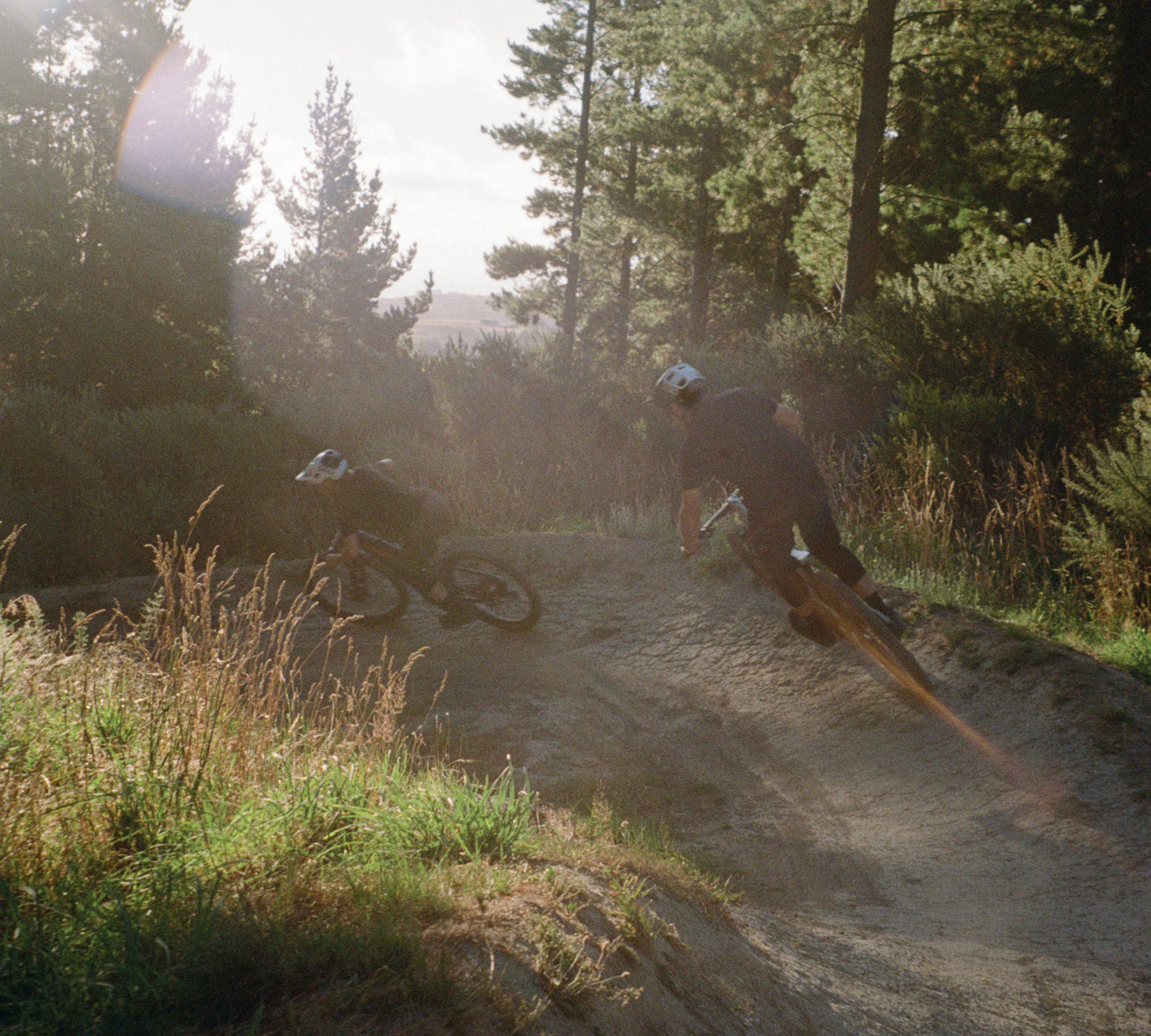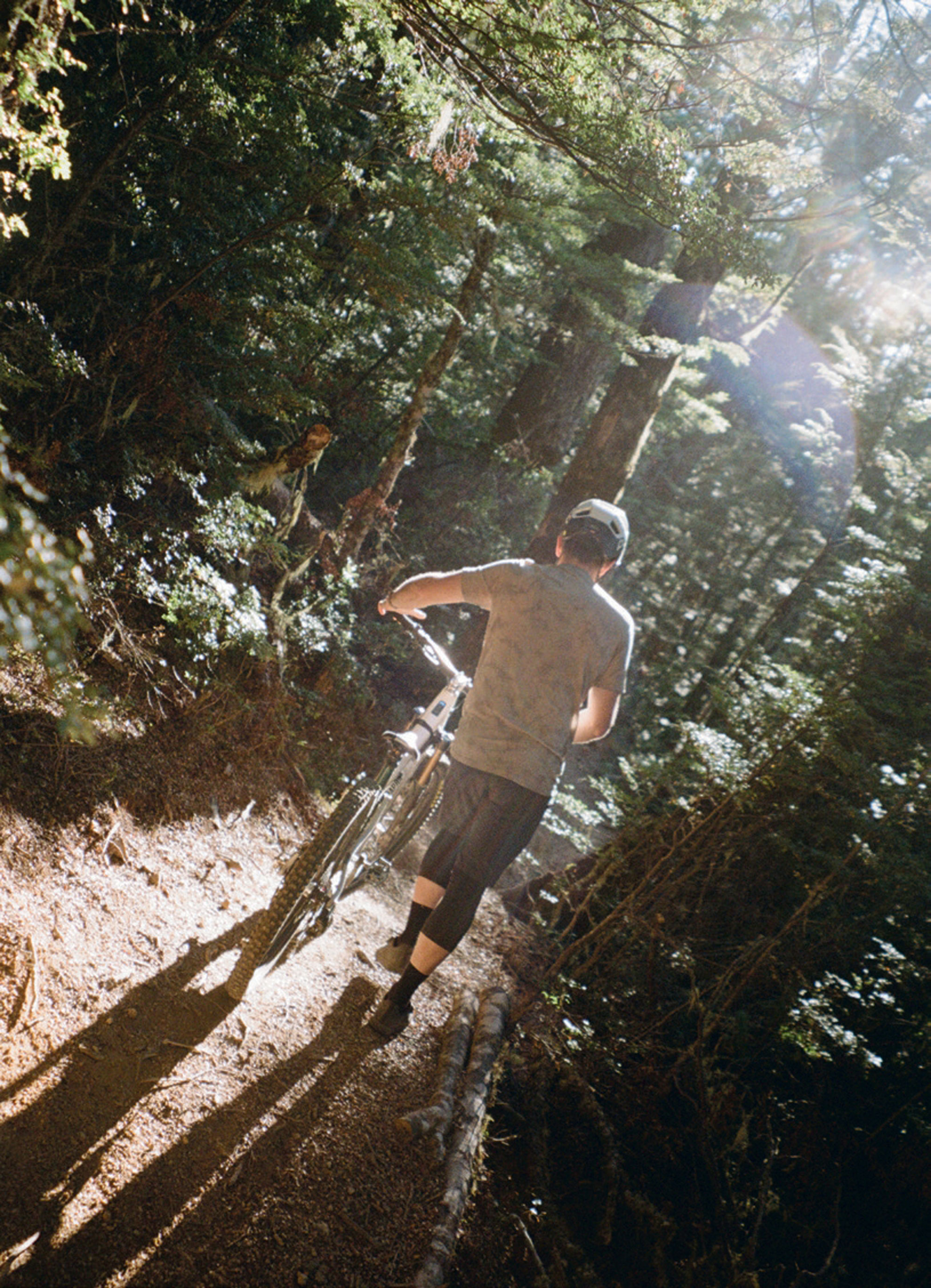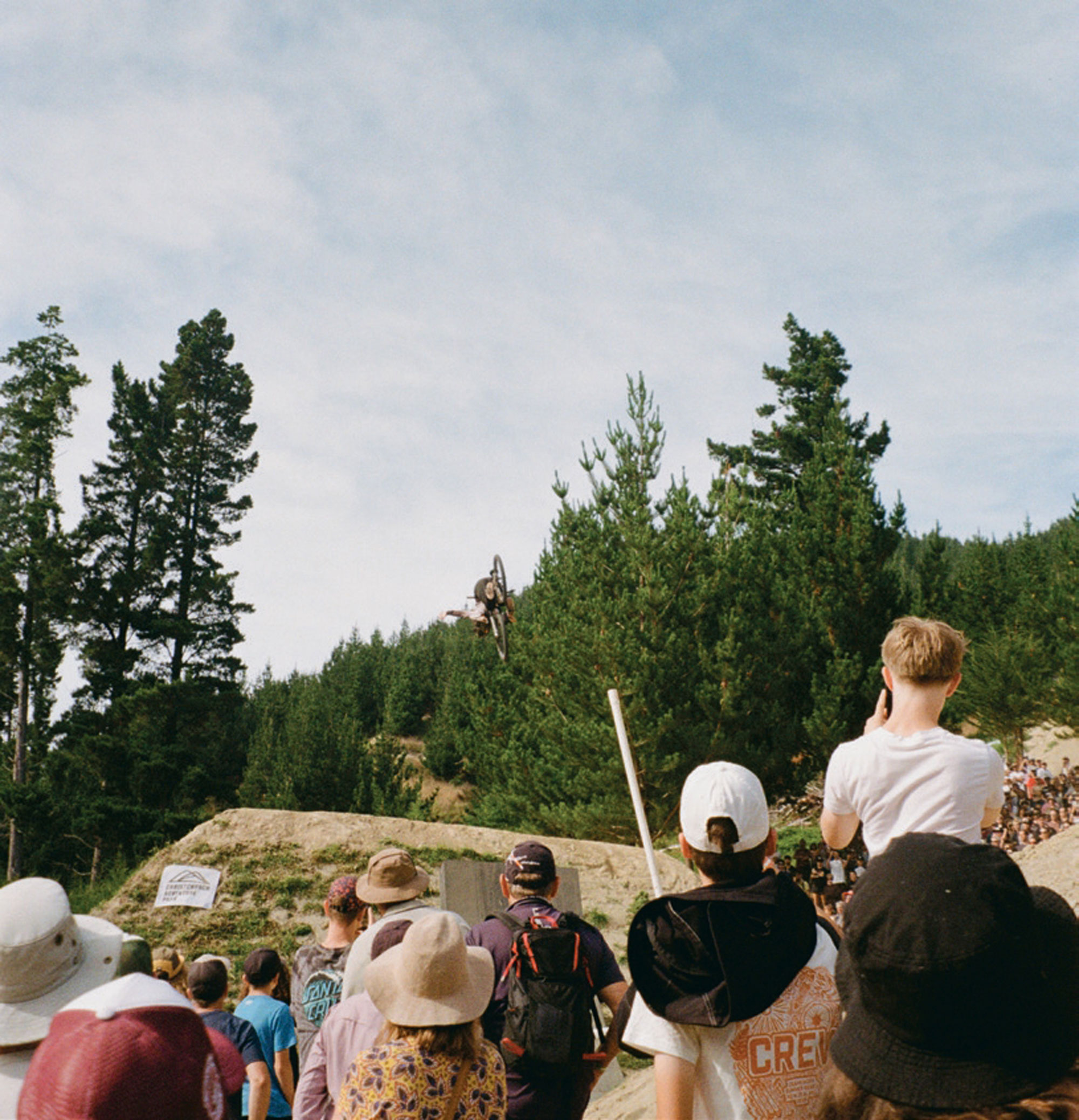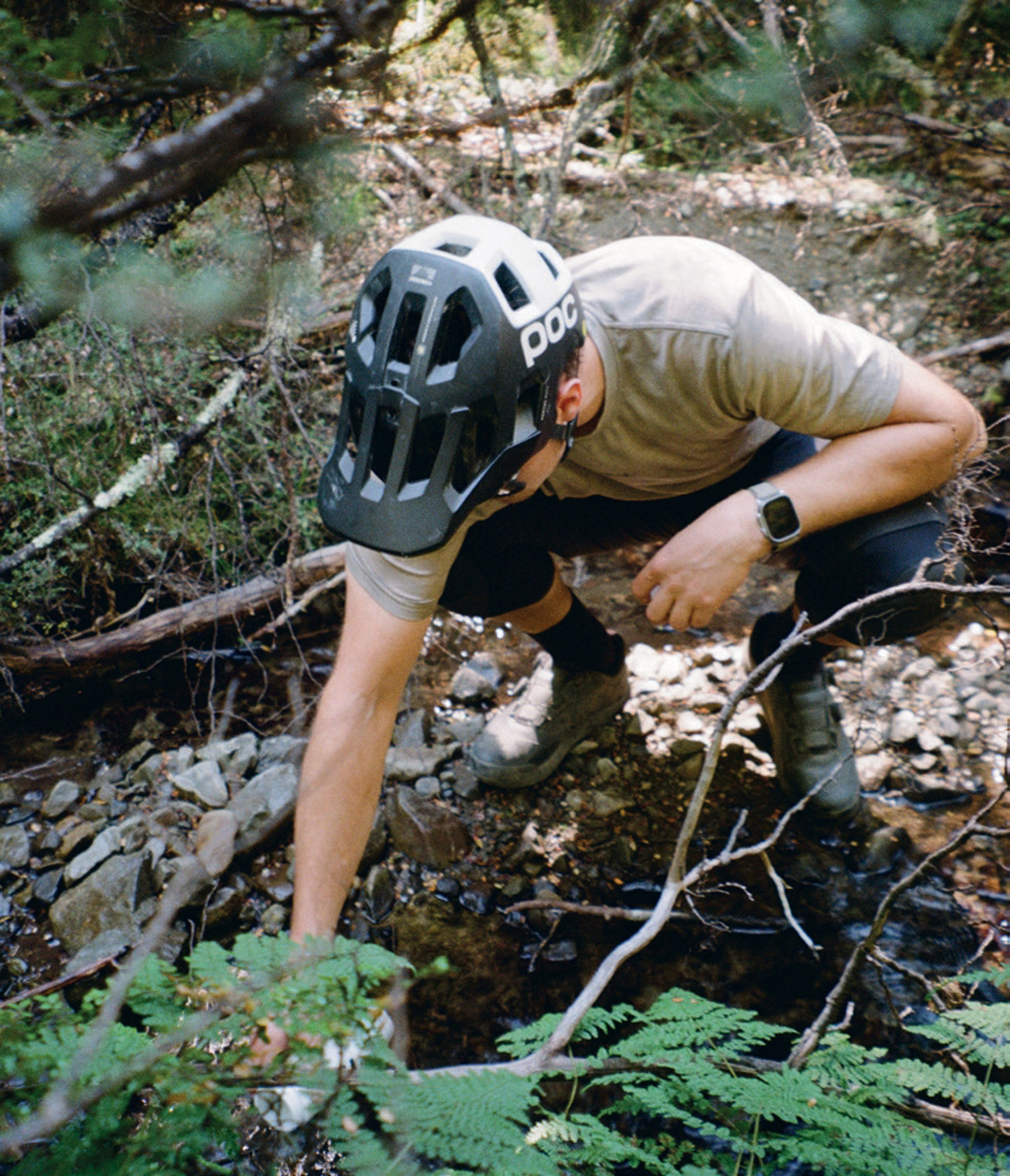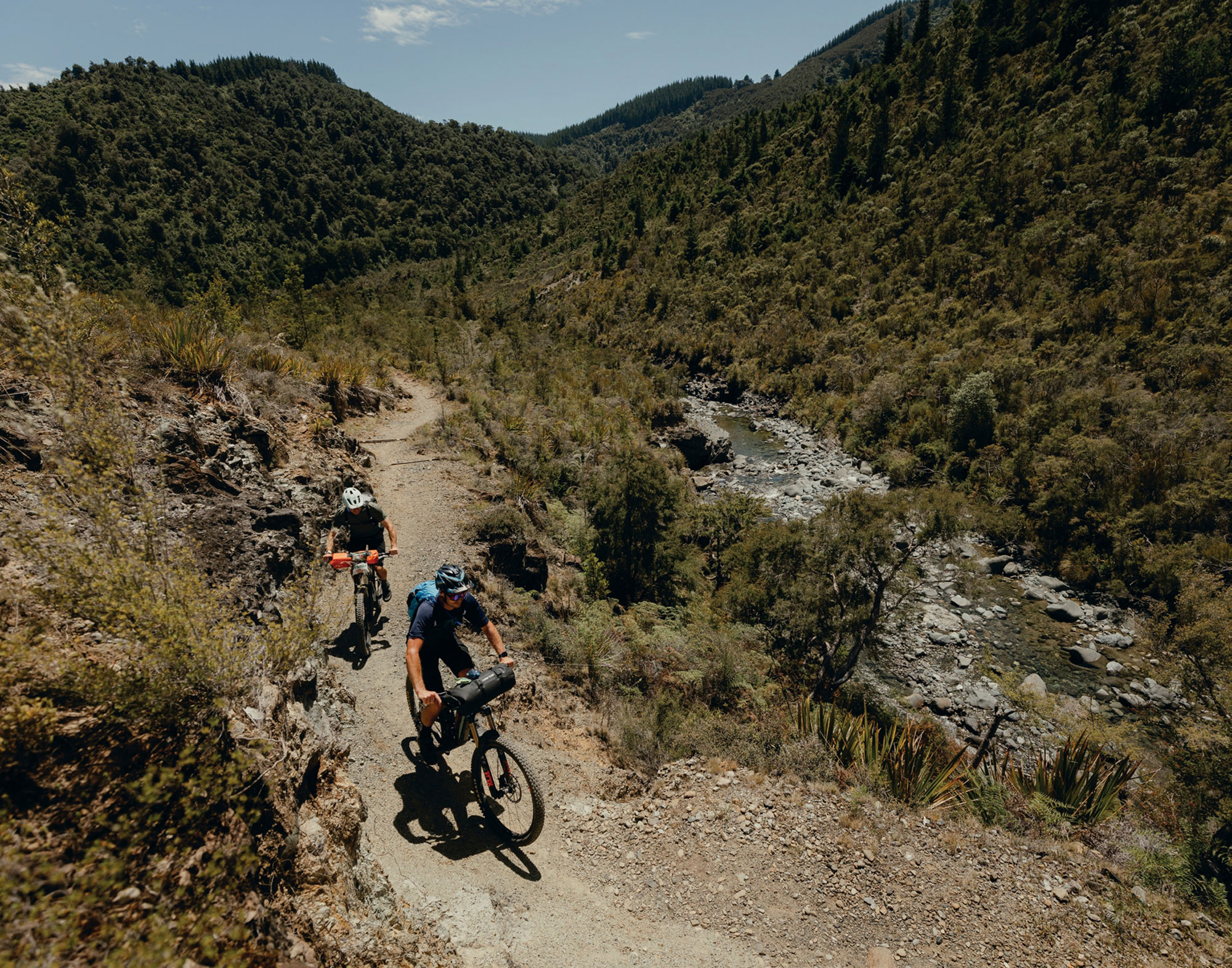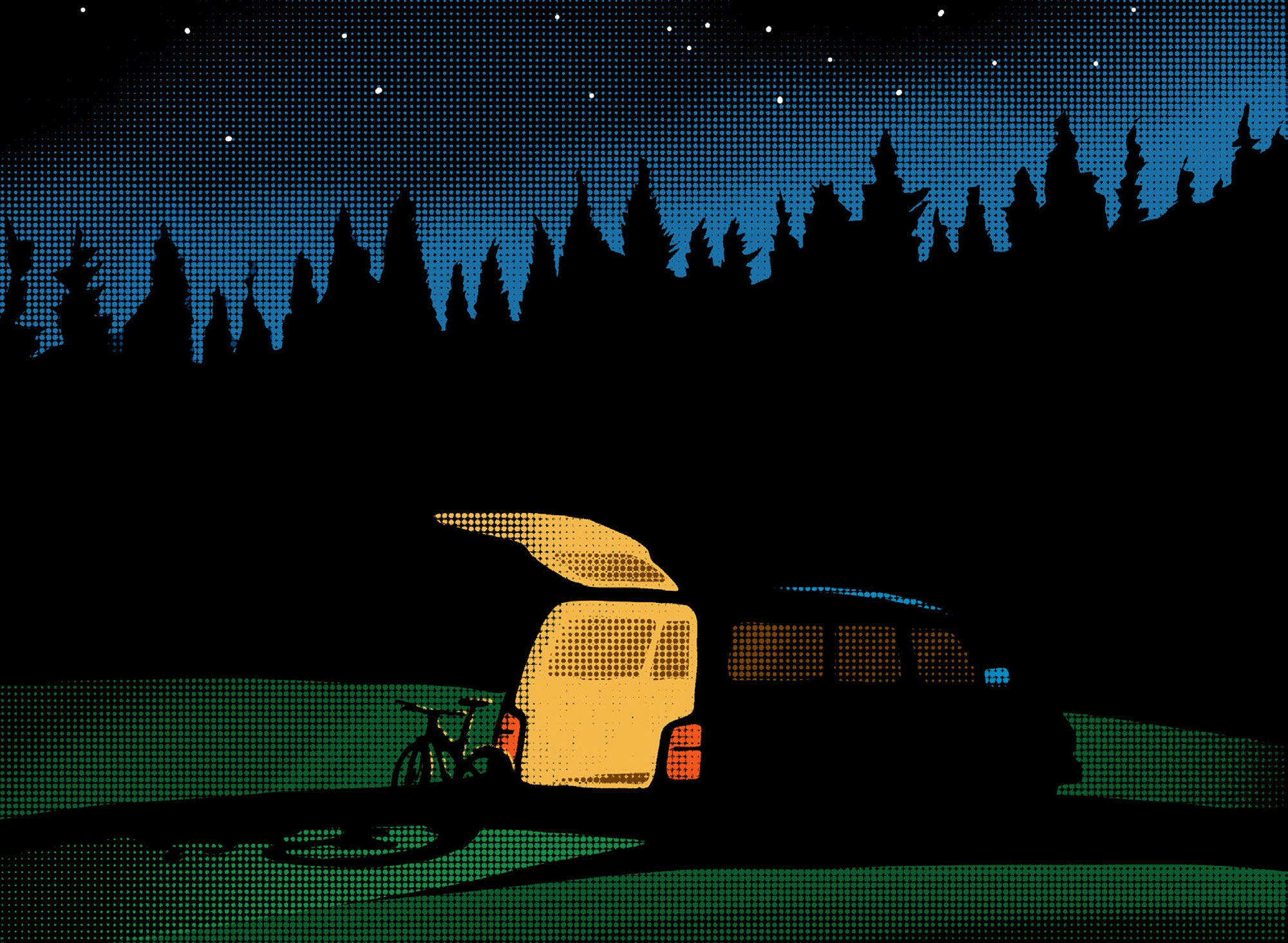Crankworx Summer Series
Words & Images Liam Friary
The magnetic pull of Aotearoa’s southern landscape never fails to captivate my spirit. When the invitation arrived to journey to Christchurch for the Crankworx Summer Series, there wasn’t so much as a moment’s hesitation in my response. I packed my gear and threw in a 35mm point-and-shoot film camera – an Olympus MJU II – to capture it.
The thriving mountain biking community in Ōtautahi continues to expand impressively and leaves me in awe each time I return. Within hours of touching down, I found myself pedalling up the Port Hills and into the trails of Victoria Park; it wasn’t long before I was lost but, luckily, a smartphone makes pinning locations easier. After that I stayed not far from the back wheel of the local guides. The hours flew by and as the sun dipped we headed for some grub and beer at Moon Under Water. True to form, the place was absolutely chocka, with barely room to squeeze through the animated crowd of riders and locals. The telltale collection of mountain bikes stacked haphazardly out front proves this is indeed the place where the biking community congregates.
Before immersing myself into the Crankworx spectacle, I ventured deep into the backcountry. I like to ride before I watch riding as it gives a good energy. The alarm screamed, I ran a quick shower, and we were off before the first light of dawn—heading out to Craigieburn for a couple of hours of riding. The best way to get the most out of the trails is on an eMTB so, with the help of a local guide, we did the ‘classic hits’ of Craigieburn. It was so damn lush through the beech forest, with the mountains peeking out every so often. The trails keep you on your game with technical rooted features, exposure, and flat out fast sections—where I was hauling a bit too much at some points. Towards the back end of the ride, we filled our bottles with water from the river and washed our faces. The stoke level was high as we pedalled back and I cracked up when my eMTB ran out of juice just before reaching the truck. The legendary Sheffield Pies warranted not one but two visits, to fuel and refuel my energy stores. After a quick wash at my digs I managed to arrive at the Crankworx event in time to catch the afternoon’s competitions.
After the disappointment of the inaugural event’s cancellation, anticipation had built tremendously for this second attempt. The electric atmosphere was felt from the moment the Uber driver drew up close to the event. This was a real vibe, with groms left, right and centre, frothing. The industry’s prominent presence, combined with the genuine excitement of the locals celebrating this event in their hometown, created an infectious energy. I walked around chatting to people from the biking scene and it reminded me that we are a strong community. I mean bikes are a bloody good tool for bringing people together. The crowd was a wide spread of age groups with heaps of families. It makes me think these events keep the next generation inspired. The crowning spectacle of the Crankworx Summer Series is the Slopestyle competition. The wind had been playing a bit of havoc during practice so it was decided to move the event to early Sunday morning. I walked up the hill—the crowd was littered everywhere, in high spirits waiting for the next rider to drop. The hillside hype was infectious and being a part of live sporting action is something really special. The athletes really threw down and this grassroots event even managed to rival its bigger brother. Those few days immersed in the Crankworx Summer Series, combined with a quick trip into the backcountry, reminded me just why bikes—and the mountain biking community—are so bloody good.
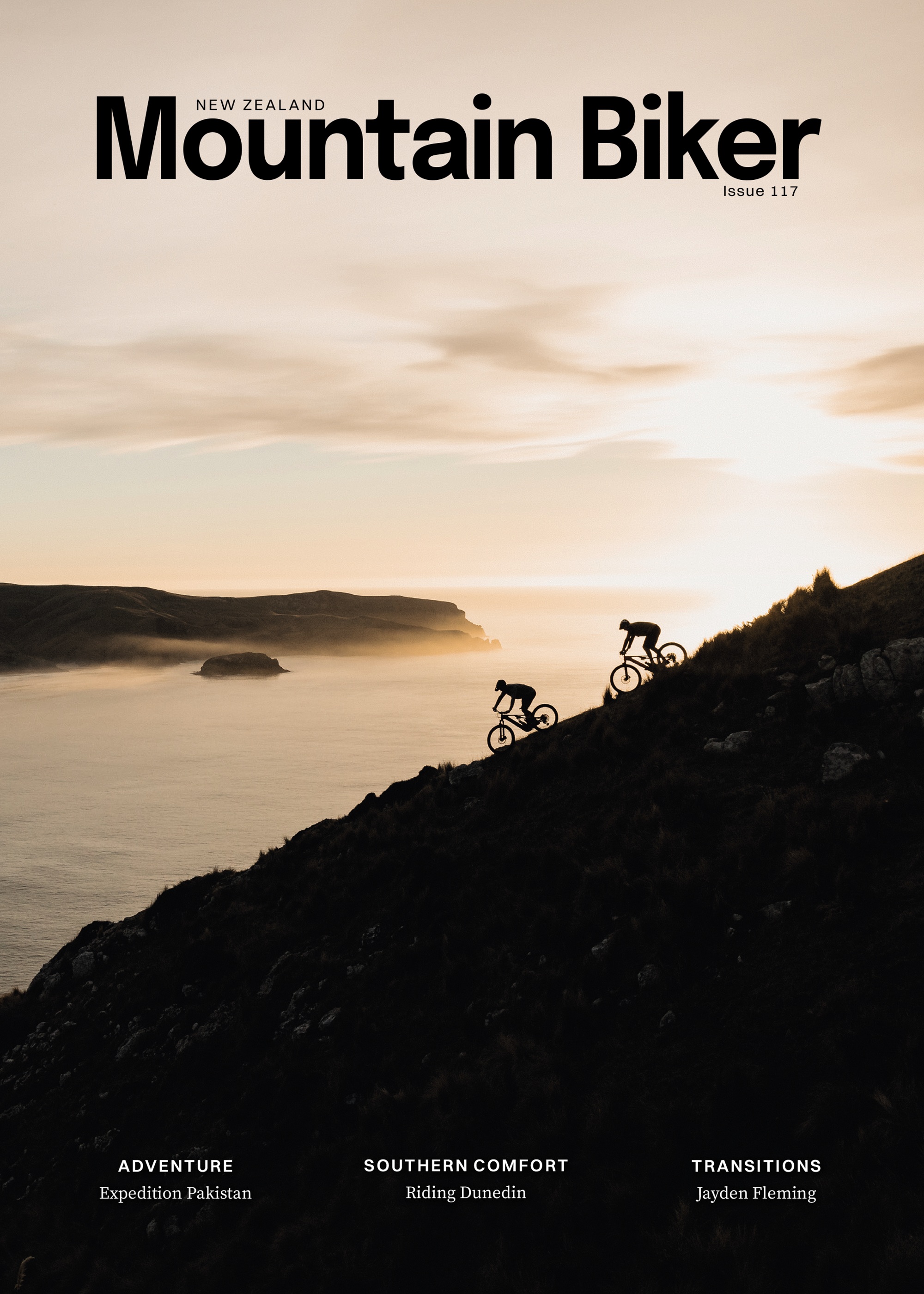
Metronomic Meditation
Words & Image Gary Sullivan
“It gots to be accepted;
That what? That life is hectic.”
C.R.E.A.M. by Wu-Tang Clan
Although they’re all credited with writing their legendary song, C.R.E.A.M., I’m pretty sure it didn’t take all of the Wu-Tang Clan’s nine iconic members to write that lyric from their debut 1993 album. Whether they all pitched in, heads bobbing as they gathered around a smoking ashtray, behind a mixing desk, or if it were just a single MC with a pencil and notebook scratching notes while on a grimy subway, one thing is for sure: there was one purpose. Whether a posse of nine or an army of one, single-mindedness helped create the masterpiece, confirming we need to accept that, indeed, “life is hectic”.
It’s how we deal with our hectic lives that matters.
And there are many ways to deal with how hectic life has become recently. For most, it’s a combination of different things that take their mind off the busyness of life; for others, it’s singlemindedness, or a single act, that calms them, enabling a refocusing of the mind—away from the stressors of daily life. If you’re reading this magazine, I’m sure that—for you—one of these things is probably mountain biking; a single-minded act. I know for me, personally, at times, riding is more than just a sport; more than just an activity to fill a couple of hours. It’s a meditation of sorts: a metronomic meditation.
Metronomic meditation. I didn’t come up with this phrase but, when I first heard it, it struck a chord. Meditation is “a practice that involves focusing or clearing your mind using a combination of mental and physical techniques”. Both are things that mountain biking requires. Particularly on a technical descent or fast-but-flat singletrack, focus is paramount. I can think of countless times where, had I not been 100% focused on the task at hand, I’d be down a bank, over the bars, or have slid out on an ice-like, wet clay surface. That need for focus means clearing my mind of clutter and forgetting the day-to-day. There’s no space for thoughts other than those required to keep the ship upright, and should my mind wander back to ‘normal life’ even just a little, the consequences could be painful.
Several factors add the metronome-like aspect to mountain biking. Firstly, the pedalling. Stop pedalling while on the flat or going uphill and we fall over; it’s pretty simple. If we’re out for a big day on the bike, the metronome- like effect of pedalling can last hours with only a marginal variation of cadence. It’s simple to ignore, but we’re often pedalling 80 times a minute—multiply that by three hours and 14,400 rotations, which is no doubt metronomic. Then there’s the metronome of our breathing, which is directly related to our pedalling cadence and power. Both affect our breathing, how deep it is, and its frequency.
Boil it all down and it’s pretty basic, really. Between our 100% focus on the trail and the subconscious metronome of our cadence and breathing, we can slip into a trancelike state. Now I think about it, some might call this the ‘Flow State’, but for me, ‘Metronomic Meditation’ is equally adept because we essentially remove ourselves from reality and are forced to cleanse our mind of the day-to-day—a ‘mind bath’ perhaps.
As much as I’m a mountain biker at heart, I spend a lot of time on my local roads, asphalt or gravel. This riding ticks the sporting and physical aspects of riding for me, but I find it’s only partially metronomic meditation. Roads are wide, and I don’t need to pick a cautious line between obstacles or weight my pedals just right across an off-cambered section. I can just concentrate purely on pedalling and staying on my side of the six-inch wide white line, still able to contemplate my daily problems and figure out what I’m having for dinner. There’s undoubtedly some metronomic pedalling and breathing happening, but it’s hardly meditation.
Life is hectic. It’s fair to say, at least for me, mountain biking is the truest form of single- minded metronomic meditation that eases that hecticness (is that even a word?!), if even just for a few hours a week.

Give it time
Words Lester Perry
Image Henry Jaine
Some bikes are ridden so often, and in so many moments and places, that to part with them becomes almost impossible.
They develop value to the owner which has no connection to reality, so selling them is not only unsatisfactory from a financial perspective, but an emotional wrench that can be too difficult to execute.
Same goes with cars.
Our relationship with our vehicle is kind of like the way we treat drivetrains. There are essentially two ways to do that: keep it fresh by replacing the chain every thousand kilometres; keep an eye on the chainrings and replace them when necessary—and hope that doing those things will make the cassette last longer than it may otherwise. Or the other way, which is ride the stuff until it more or less dissolves, then replace the lot in one mad spend-up after a couple of years.
The more traditional among us get a nice set of wheels when they are able, then trade in or up as often as once every couple of years. The alternative lot buy a vehicle that ticks the required boxes and drive it until it dies—or they do.
That has been my style and, so far, I have outlived half a dozen of them—not counting the odd ones I owned briefly in my youth, and the more sensible ones I have shared with my partner.
The last three have been Toyota HiAces. These venerable buses are examples of what I would argue is the Kombi of the South Pacific. These days, actual Kombis are like high end bicycles: their price bears no relation to their functionality. Don’t get me wrong, they are cool things. In their primitive way they will still be clattering along when cockroaches inherit the planet. But, for everyday abuse and long- lived up-for-itness, the HiAce is hard to beat.
Also hard to kill.
The late 80s white example we caned for a decade, had a slipping clutch for at least five years, which Glen used to repair using positive thinking. Just when we thought it wasn’t going to get whatever pile of stuff we’d loaded into it to the top of the next hill, she would send it kind thoughts and it would take another deep breath and soldier on. Some dear friends took it off our hands and toured the country in it, before selling it to a wrecker in Christchurch.
The one I almost wear as a totem is called a Regius, but it is a HiAce at heart. Sidebar: I reckon a good career, if I was a younger man, would be as a consultant to Japanese car companies, helping them to avoid coming up with names like ‘Regius’. And HiAce for that matter. But, I digress. I have heard this model referred to as a “Loser Cruiser”, but it has carted me, my partner, numerous bikes, a kayak, and a caravan over a quarter of a million kilometres around our country and still goes like it did when I got it.
I have just replaced it. I decided that if I get a decent HiAce now, it will probably be the one that stays on the road longer than I do. I took delivery of it last week, and told a friend about it that evening. I honestly thought she was going to cry. In her view, the old van is part of me. “Surely you can’t be going to sell it!” she exclaimed.
Well, that is the plan.
That was the plan. Now? I am not so sure. Yes, yes, I am. Out it goes.
So what’s the attraction for me, in a HiAce? Mainly; that it’s a van. You can drive around in it. You can keep a bike in it. You can get changed in it, take a nap in it, take shelter in it. You can cart a collection of bikes and people, a pile of rubbish, or half a house load of furniture. You can go camping in it—at a pinch, you could live in it. We have done all these things and more.
I prefer to get one that is past the number of kilometres travelled where problems would have cropped up if they were going to. It is best if the thing already has dents and scratches in the usual places. That means any imperfections I add to it will be pleasant memories of tight spots or straight fuckups, not heartbreaking blights on what was a virgin body.
The new one (well, new to me) has very little personality. Personality will develop, as bits of bark get scrubbed off the corners, bicycle tyre marks get added to the interior, kilometres get added to the clock and resale value slowly becomes irrelevant because with any luck I will never sell it.
Like one of my road bikes, it will become so valuable to me, it will be more or less priceless.
Give it time.
Join Trail Fund as a member to support our advocacy efforts!
Words Meagan Robertson
Image Callum Wood
Not another mountain bike club membership!? Yes, we know. There’s a lot of hands out asking for your money these days, and a lot less money going around. That said, there’s also a lot of debate and drama over trail users, trail guidelines and trail etiquette – and if Trail Fund is going to continue to put its hand up and suggest some strategic ways forward, we need to be able to prove how many people believe in our cause.
What is our cause?
Trail Fund is the only national body that represents and funds trail builders throughout the country. Over the past 13 years, our volunteer- run organisation has distributed more than 120 grants, totaling more than $300,000, to 50 clubs around the country. We also made sure mountain bikers have a seat at the table when it comes to trails on public conservation land, by joining forces with Federated Mountain Clubs and New Zealand Deerstalkers Federation in 2014 to create the Outdoor Recreation Consortium (precursor to the Backcountry Trust).
Our advocacy representative, Jimmy, has also been working tirelessly for six years to realign DOC’s re-classification of bikes on public conservation land as ‘vehicles’, in 2018. It caused significant delays to projects around the country, leaving several passionate volunteers feeling defeated. It also meant that iconic trailsincluding several Great Rides – did not comply.
It’s been a slow process but Jimmy and representatives from various other local clubs are finally gaining traction, and earlier this year he prepared the Trail Fund submission for the Department of Conservation (DOC) on the modernization of conservation and management. This submission can be found on the Trail Fund website and recommends adopting an effects-based approach, improving resource allocation within DOC and ensuring a more equitable concession system.
Back to the money and membership.
As above, we aren’t doing this for the money – we’re doing it for the memberships, and we will have two different levels – individuals and clubs.
Individual memberships are $8 and include a Trail Fund member sticker – or free when you purchase any Trail Fund item in our online shop for the next two months.
Club memberships – which automatically translate to individual memberships for every club member – will be $25. Clubs will need to be members to apply for funding rounds going forward.
That’s the gist. No drama, little money, big impact.
We look forward to welcoming you to the club – officially!
April funding round now open!
Got your membership sorted? We have two ebarrows and ten Weapon of Mass Creation tools up for grabs – so get your application in now. Applications will be accepted until 15 May.
Learn more:
trailfund.org.nz/products/trail-fund-nz-membership-2
Leatt Products
Words Lester Perry
Images Jamie Fox
RRP $249—ProClip 4.0 Shoes | $119 — Velocity 4.0 MTB X-Flow Iriz Goggle $69 — Glove MTB 2.0 X-Flow Stealth
Distributor BikeCorp
I remember wandering the expo at Crankworx 2020, in Rotorua, when I was called over to the Leatt booth with the promise of seeing something exciting. I was indeed excited as I checked out Leatt’s first range of MTB shoes. It wasn’t perfect, but it showed glimmers of hope that Leatt could become a legitimate player in the MTB footwear game, completing their head-to-toe ethos.
ProClip 4.0 Shoes
Fast-forward five years and I’m rolling deep in a fresh pair of Leatt ProClip 4.0 shoes to review. The 4.0 ProClip is a gravity-focused shoe that aims to protect – rather than be lightweight – without detracting from pedalling performance or power transfer.
There’s no missing the MOZ dial cable lacing system at the front and centre of the tongue. MOZ allows micro-adjust tension, with a pull to release its complete tension. The system makes for an easy-on, easy-off shoe. The dial is simple to use and has a decent rubberised outer edge, allowing it to be tensioned as tight as you’d ever need. I’ve encountered some dial styles that don’t have enough grip to grunt on them, but they work well. Over the front of the foot seems to make more sense than the all-too- common venerable dials on the side of shoes.
My only comment on the MOZ would be that it would be nice to see micro-adjust for tension release rather than the pull release that dumps all the tension in one go… but perhaps I’m being a little picky, and it’s by no means a deal breaker. A nice firm Velcro strap tensions the ankle area; there’s no stretch in the strap, so I can pull it nice and tight. I need to get it in just the right place to give perfect tension as there is no ‘give’ in the strap, meaning once it’s in place, it stays firm.
Visually, the shoe takes cues from the classic skate shoes of the 90s. The ProClip 4.0 doesn’t strike a slim silhouette; they’re a protective item, so we wouldn’t want a shoe that’s too slim. There’s no excess padding to absorb water; once wet, they dry pretty quickly compared to some. The outer is a mid-cut with a higher neoprene cuff to keep the loam and niggly pebbles from entering the shoe. It works great and has the nice touch of being slightly perforated to help with breathability. Heel and toe reinforcements offer some peace of mind that your tootsies should come out unscathed after those sketchy moments when you’re dabbing feet, or clipping a sniper root with your toes.
The gum sole is oh-so-hot right now. It features a familiar waffle pattern throughout most of its length, with strategically placed lugs under the toes and heel for walking grip. Thanks to the RideGrip rubber compound, the platform is surprisingly stable when not clipped in, assisted by a shallow concave section under the arch. A soft EVA midsole makes them comfy on foot while walking or hiking. The EVA does a noticeable job of absorbing chatter and vibrations, helping to reduce fatigue in the feet and lower legs. Traction for walking is reasonable in the dry, and the rubber is tacky enough to offer confidence, although scrambling around in the mud is as slippery as you’d expect; these are riding shoes, not hiking or “all-mountain” shoes. Pedalling stiffness is similar to the pair of Shimano GE-700s I recently reviewed, with a good medium flex for efficient pedalling and comfort for standing in lift queues or hiking jump lines. The 4.0 ProClip could take the win for having the most extended cleat channels in any shoe I’ve seen – there’s a serious amount of fore and aft adjustment, allowing for an almost mid-foot through to under-the-toe cleat mounting if you so desire. Gravity riders rejoice.
Size wise, I found these run on the larger size compared to most, so you may be able to downsize. As with almost all footwear: try before you buy.
Overall, the ProClip 4.0 is plenty comfortable and offers great protection for all eventualities. I like the mega cleat channels; it’s the first shoe I haven’t had to slam my cleat right back on. They aren’t the lightest or stiffest shoes out there but, if you’re more suited to cutting downhill laps, riding shuttles or just goofing off on the bike rather than pedalling significant distances, you can’t go wrong with these.
Velocity 4.0 MTB X-Flow Iriz Goggle
Ask anyone who’s gone over the bars and landed on their face if they think goggles are an essential part of their protective kit, and I’m confident you’ll get a resounding “yes”. Speaking from experience and a nice scar down my cheek, I’d agree. On a hot January day, while practising for a downhill race at Cardrona, in the early 2000s, I stopped on a corner to remove my goggles as they were saturated in sweat and stifling my face. As I rolled back onto the track my front wheel caught a rock, and I was pitched headfirst down a bank. A rock shot the gap in my full-face and got me just beneath my right eye, splitting my face open like a tomato. Fortunately, I sustained no lasting effects other than a scar, but the doctors determined the cut was millimetres from causing severe damage to my eye. The funny thing is, had I been wearing the Velocity 4.0 X-Flow goggles, I’d probably not have overheated and would have kept the goggles on rather than hanging them off my handlebars, and likely walked away from the crash with just a bruised ego and scratched goggles. Goggles or glasses? I’m not entirely sure what to call these. They have advantages similar to glasses but with the extra cushion and a more secure fit. They also have the protection and field of view of goggles, which is, to some degree, the best of both worlds. Mountain bike riders generally don’t see the same speeds as motocross riders, and there’s seldom debris or dust flung from a rider in front, so in the form of the 4.0 X-Flow, the traditional moto goggle has been tweaked to suit mountain biker’s needs.
The use case for wearing goggles has become much broader with the advent of the Velocity X-Flow series from Leatt, which has ruled out – or at least minimised – the downsides of wearing regular goggles. The minor trade-off of having open areas in the frame is that debris could make it into the goggle cavity. I haven’t experienced this, but I imagine it could happen, particularly in the wet, when worn with an open-face helmet.
The fit is similar to that of a good pair of goggles, with a twist. Leatt designers strategically removed sections of the foam padding, allowing for a vast amount of breathability from the top and bottom of the frame. They also nailed the look by keeping them looking like a pair of goggles, rather than the more polarising hybrid goggles/glasses style of some competitors.
The Rideviz lens features permanent anti-fog and scratch-resistant coatings and meets the ‘Military Ballistic Impact Standard (MIL-DTL- 43511D)’ – so the rock that pierced my face wouldn’t stand a chance against this lens! The Iriz tint strikes the sweet spot between being too dark and too light; I find it spot on for almost all conditions, taking the harshness out of the light on open trails but not dark enough to dull the scene too much when in the bush.
My first outing with these on my face was a jaunt aboard an eBike on a muggy, blue sky spring day, not the usual conditions for me to reach for a pair of goggles. The increased airflow over a regular goggle was immediately noticeable. My face didn’t feel sealed in a hot box, and air flowed between the lens and my face, controlling the temperature. The field of view is mega and no different to a quality set of goggles.
The top foam absorbs sweat, which is excellent until it becomes saturated; at that point, I occasionally experience a drip of sweat down the inside of the lens. On a stinking hot day, the X-Flows are still warmer than sunglasses, but not by much. Since the lens sits further from the face than on glasses, they collect less sweat on the lens, and there’s a significant increase in protection, too. The mesh strap is a nice touch, theoretically allowing some breeze to pass through into the helmet vents—a hard one to quantify, but I see no reason it wouldn’t be the case.
I’ve become a fan of these goggles. I appreciate that they resemble traditional goggles, and Leatt has nailed it regarding breathability. I now wear them in situations or rides where I wouldn’t have even considered it with regular goggles—thumbs up.
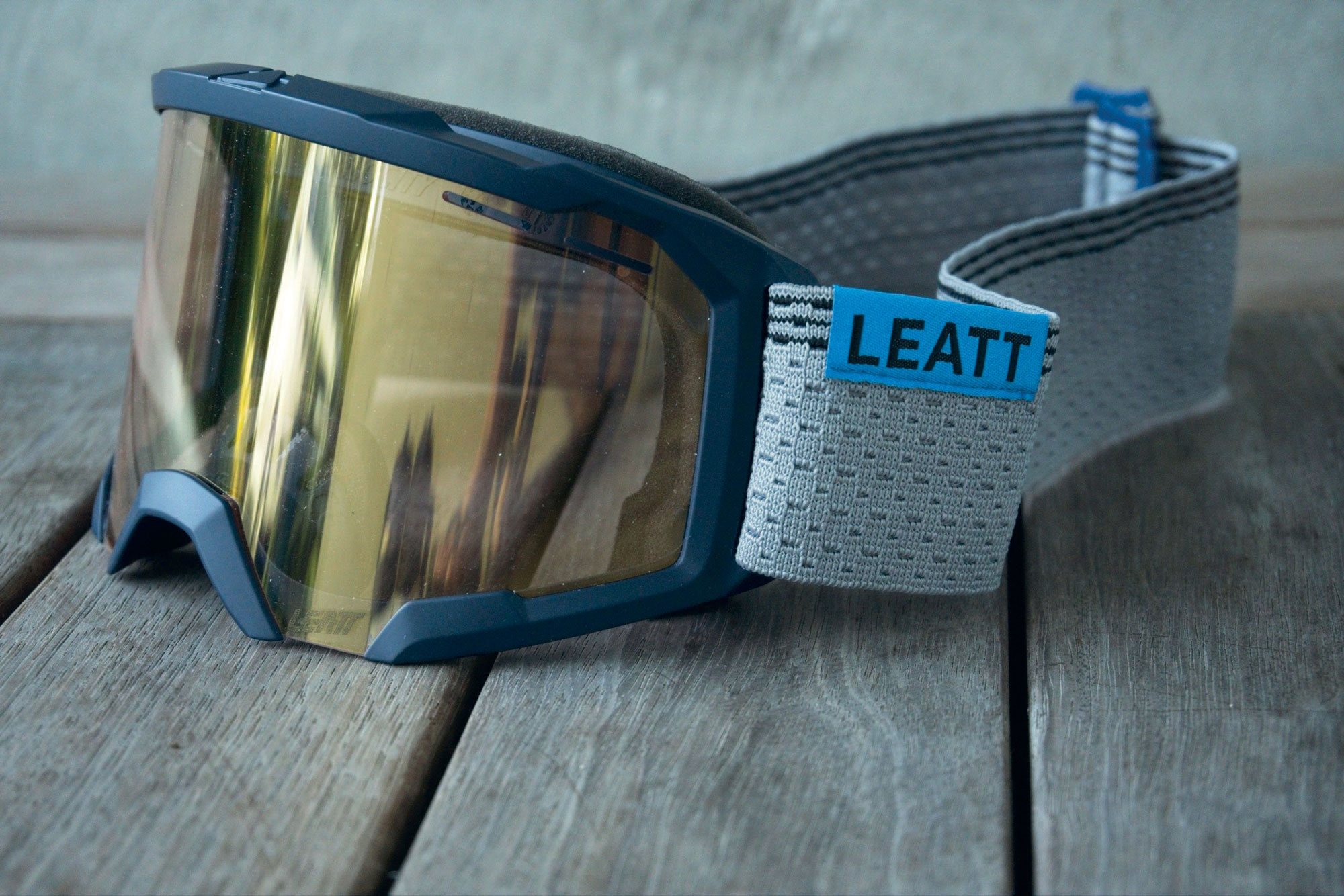
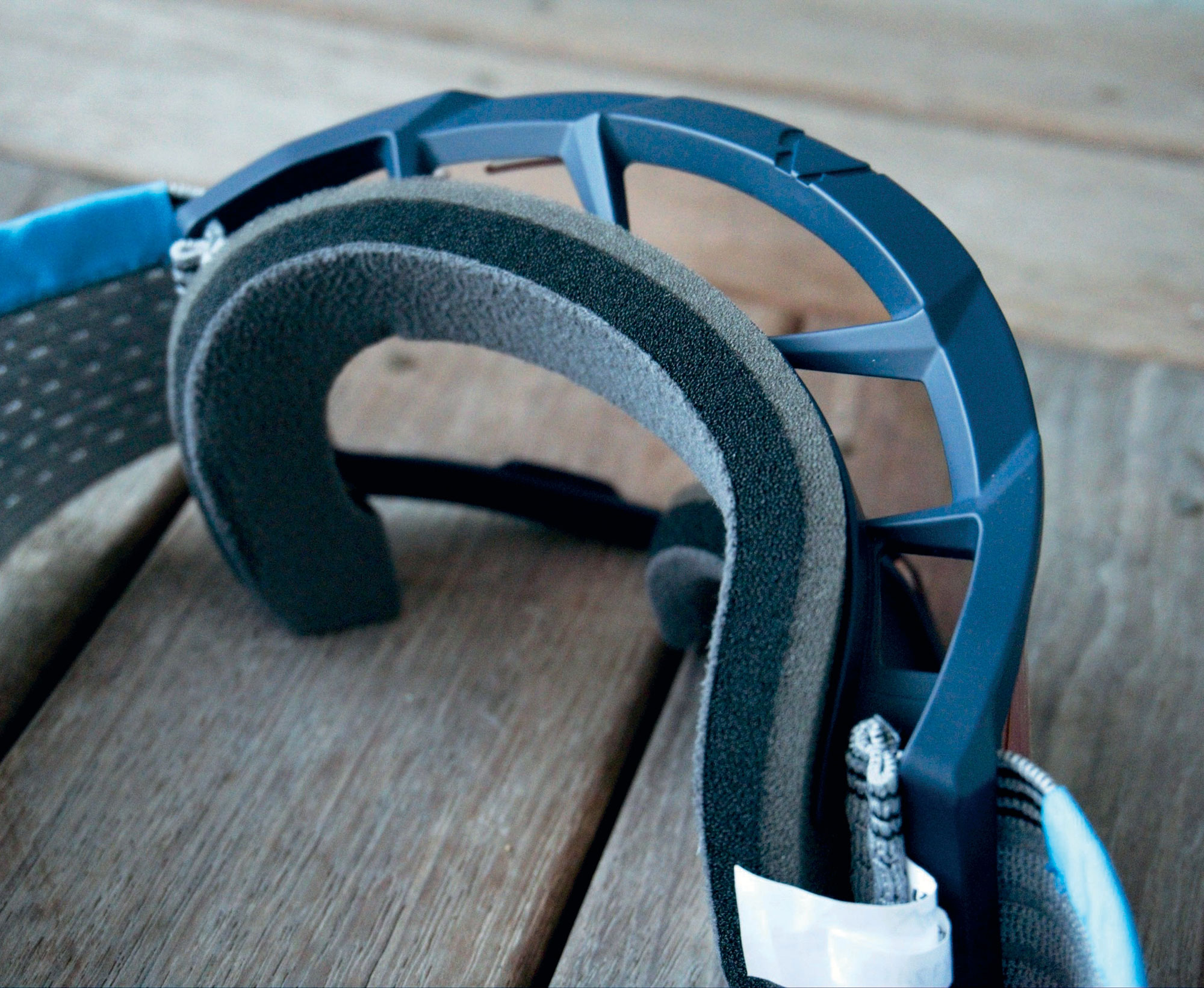
Glove MTB 2.0 X-Flow Stealth
Is it me, or have gloves become a consumable, throwaway item? Back in the early 2000s, a pair of gloves would literally last me seasons, and my riding volume was probably twice what it is now. Since then, quality gloves seem more and more difficult to find, particularly if you’re chasing something lightweight and breathable that will last more than a summer. The stitching, particularly on the fingers, is usually the first to go, and there are only so many times I want to restitch and bodge them to be usable. I didn’t get too excited when the Leatt 2.0 X-Flow gloves arrived for review last year.
I’m pretty finicky about what gloves I’m comfortable in. A minimal palm is key, and I find the fabric tension across the back of my hand needs to be just right—not too tight to restrict movement, but with enough support to keep them snug and avoid bunching. More importantly, they must help keep the palm taut and in place. See what I mean? Finicky.
With a stretch fit and slip-on design, these take a little technique and patience to put on, but once on, the medium size fits my medium-sized hands perfectly; snug throughout with no firm points or obvious pressure points. Fingers are explicitly tailored to minimise bunching when wrapped around a handlebar, and are stitched with a specific thread to aid longevity. The main body fabric is a Leatt X-Flow material, a 4-way stretch mesh that helps with breathability and fit. Knuckles and pinky fingers get an extra layer of thin rubber material for added protection and reinforcement, adding negligible weight or bulk. The backs of the thumbs have a terry cloth wipe.
The palm is made from a single piece of Leatt’s NanoGrip material. It’s nice and thin and has a slightly furry, almost cat-paw-like surface, which gives superior grip in all conditions. The handlebar feel is exceptional, possibly the best of any gloves I’ve worn. Some wizardry in the fabric means the fingers are touchscreen compatible, which is a bonus whether you’re filming ‘shreddits’ with your mates or calling for help after a crash.
After about four months of wearing these gloves, I’m pretty impressed, and they’ve become my go- to. The X-Flow fabric has kept its shape and firm stretch, and all seams are still intact. Although the palm has some stains, it is holding up well with no signs of wear. A resounding clap for Leatt for continuing to make gear that works well and lasts the distance. There is no fast fashion here.
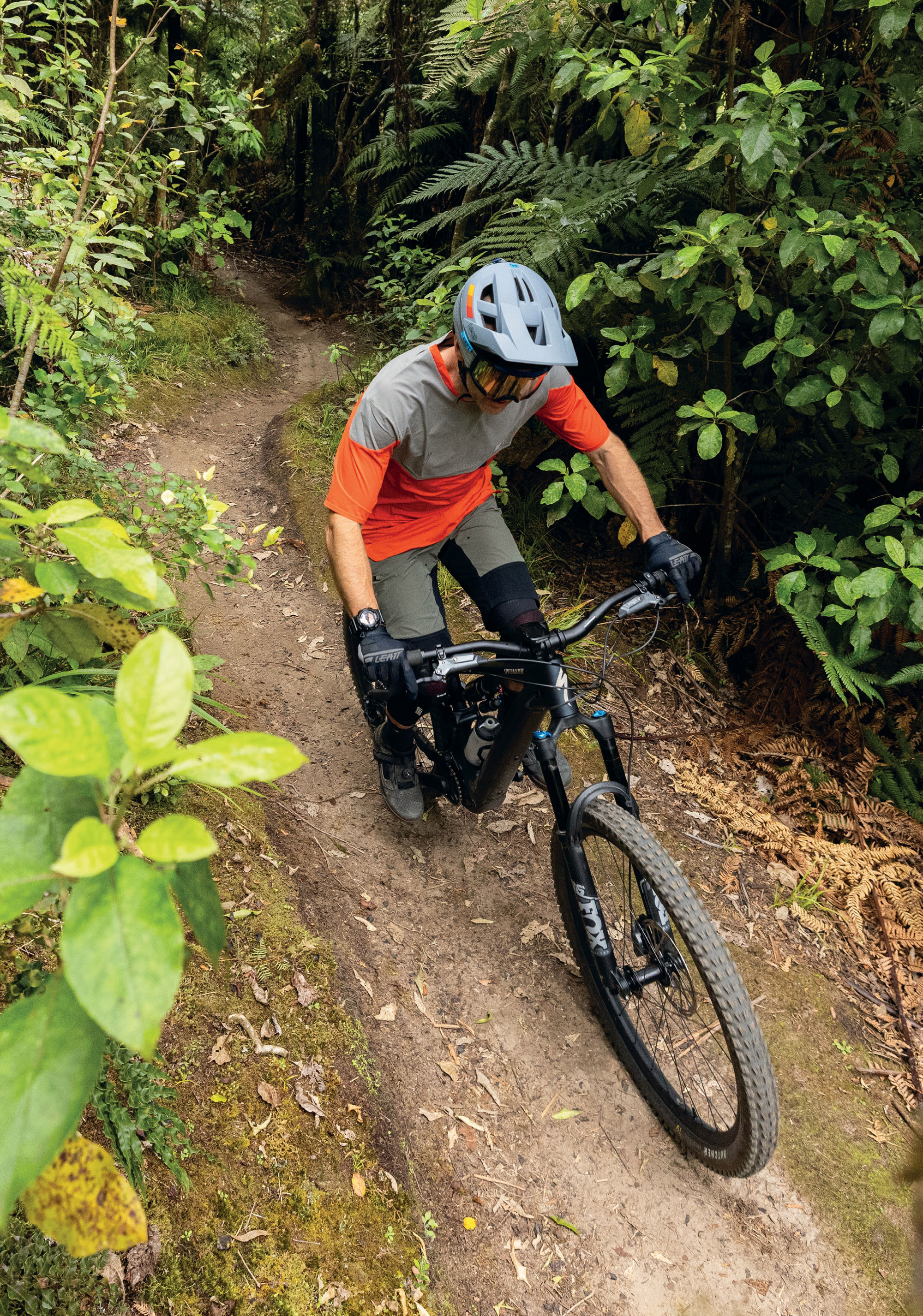

Commencal T.E.M.P.O. Signature
Words Lester Perry
Images Jamie Fox
RRP $9,200
Distributor Commencal NZ
Imagine this: The year is 2020. On a wall in the Commencal design office, there’s a mood board for a bike they’re developing. It’s covered in images torn from magazines and printed by the office laser printer, the products of quick-fingered Google image searches.
Amongst the chaotic collage of images, there’s a jet boat, a compass, a Pyrenean Ibex, a steam-roller with a big red X marked across it, one of those kid’s playground rides with a seat mounted atop a big spring, a metronome with a green tick scrawled over it, and a picture of Eli Tomac mid-whip over a motocross finish jump. Each image highlights a trait of the TEMPO—for example, the snappy handling of a jet boat and the climbing prowess of the Ibex. You get the idea.
Rumours swirled about an upcoming release after a prototype frame was teased online. With a distinctly lightweight XC build and ridden by none other than Pauline Ferrand-Prévot, would the new bike be Commencal’s entry into XC World Cup racing, piloted by PFP herself? Come 20th November 2022, speculation was put to rest as the bike officially broke cover in its final guise, under Hugo Frixtalon, in what is still one of the best bike launch videos I’ve ever seen. A short travel trail bike that would help define the category and embody all the inspiration from that design studio mood board.
Over the last five years or so, there’s been somewhat of an evolution in mountain bike geometry. Before this, if someone was searching for a bike to push their riding—and was into technical, aggressive trails—then a 150-160mm frame was the way to go. This was a necessity, to find the geometry that would be optimal to offer the rider confidence and control when tackling whatever trail lay before them. Nowadays, there’s been a pronounced shift in how designers think about geometry, and we’re finding bikes with travel in the 120-130mm region with geometry that is more suited to how most people want to ride. These bikes sit alongside those with similar travel numbers, but more cross-country-targeted geometry, on bike shop floors—an interesting dichotomy that not so long ago wasn’t the case. Rather than lugging around suspension travel (and associated weight), riders can now choose the geometry they want, coupled with their preferred suspension travel: a ‘Goldilocks porridge’ bike that is focussed on precisely what they want, rather than compromising on geometry or suspension travel.
Enter the Commencal TEMPO: A big bike personality in a small travel package. Designed for pedalling efficiency while retaining the ability to tackle whatever trail is thrown at it. The bike’s metronome graphic points to a key aspect of the bike: pedalling—like a metronome, tapping out a cadence and covering kilometres. Its geometry speaks to its gravity roots.
There’s a lot to like about the Tempo.
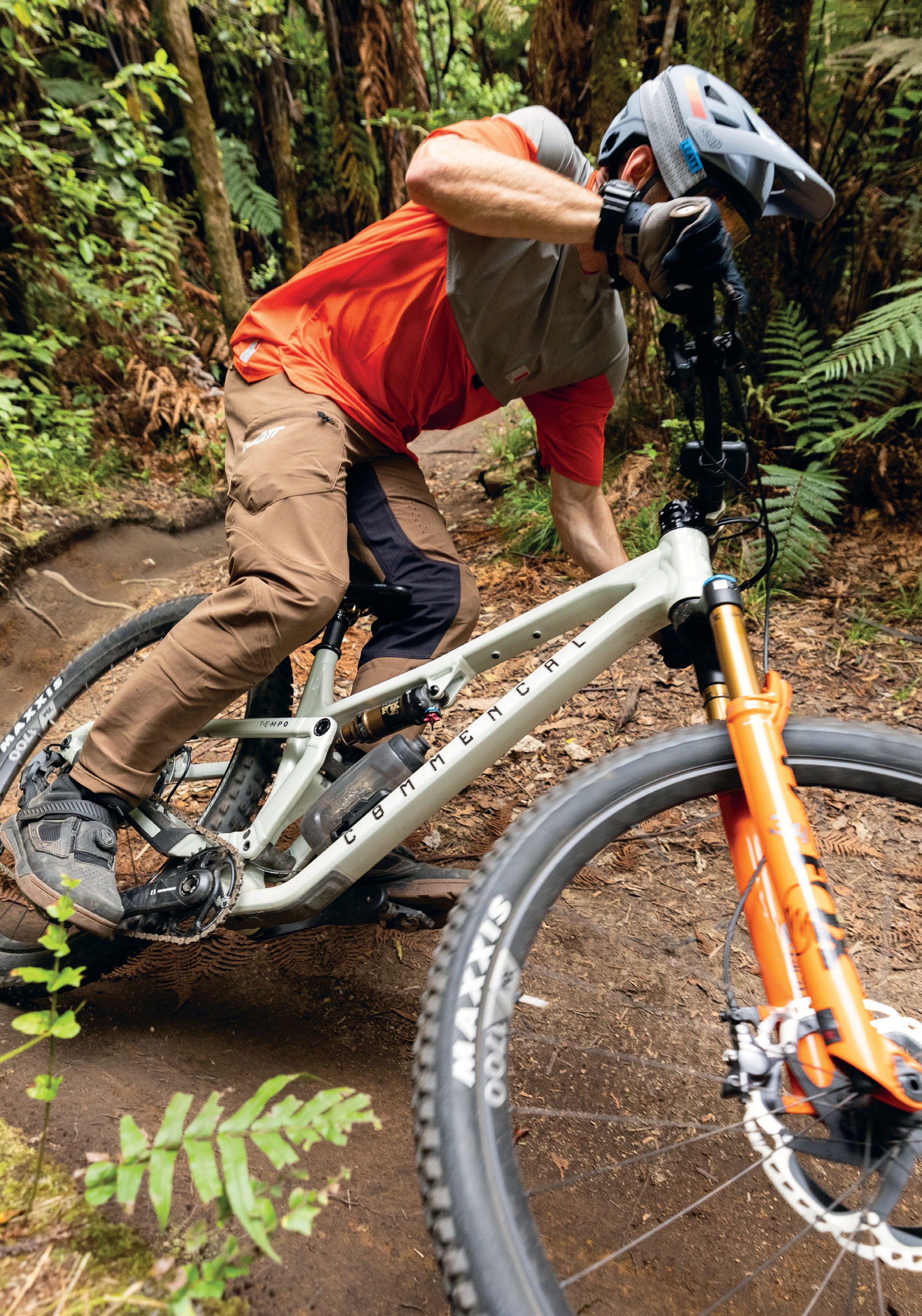
Frameset
The Tempo is based around 125mm of rear travel and a 140mm fork, aiming squarely at the short travel trail bike segment. Offered only in Aluminium, the frame stays true to Commencal’s commitment to avoid using carbon fibre, due to concern about its environmental impact.
The Tempo shares the sleek look of the Meta V5. The frame’s lines flow seamlessly from the headtube down to the rear stays. The low-slung top tube gives ample room for a rider to move around the chassis and helps keep the centre of gravity low.
Designers borrowed the Virtual Contact System (VCS) suspension linkage from the Tempo’s big brother, the Meta V5, which I reviewed in a previous issue. While maintaining the same overall function, the VCS is simplified slightly to suit the Tempo’s smaller suspension package. This virtual pivot design suits the TEMPO to a tee, allowing a reasonably supple start to the stroke, while retaining satisfactory pedalling efficiency.
Linkage pivots are all ‘through axle’ style with an expander cap to help keep them tight. They performed admirably and not once did I need to tighten any pivot point. Bearings are all manufactured by ‘Enduro,’ so I’d expect these to last longer than many OEM options. Three months in, I haven’t had any cause for concern, although most of my riding has been in the dry over summer, so time will tell.
At the end of the chainstay is the now obligatory UDH derailleur hangar, making an upgrade to a T-type drivetrain a no-brainer; a worthy upgrade for sure to get rid of one of those headset-routed cables!
There’s no funky, proprietary stuff happening with the Tempo, we find Boost 148mm spacing in the rear, a 31.6mm seatpost, and a BB92 press-fit bottom bracket—all bog standard, in a good way.
Rubber bumpers across the drive side seatstay, chainstay, and on the lower downtube, help mute unwanted noise and protect the frame from nasty chain chips or debris. Just like the Meta V5, the Tempo is surprisingly quiet on the trail, thanks in part to these bumpers.
Geometry
The geometry numbers on the Tempo are modern but not extreme, striking a comfy middle ground between an Enduro bike and a cross country bike. The ‘medium’ size I rode has a middle-of-the-road 450mm reach, a category-topping 628.5mm stack, and an almost vanilla 435mm chainstay (440mm on L and XL bikes), while the seat tube angle is “better than most” at 76.6 degrees steep. The head angle is “steeper than some” at 65.5 degrees, but quite normal for a bike in this travel bracket. All that is to say; much like the Meta V5, the Tempo has a very balanced feel, with rider weight feeling like it sits slightly further back than on the Meta V5 (which has a 10mm longer reach in size medium).
Cockpit
A complete Renthal cockpit features a ‘Fatbar Lite’ 31.8-mm handlebar that is 760mm wide and has 30mm of rise. It’s clamped in place by a Renthal Apex 40mm-long stem. This setup has a nice balance of weight, performance and value, and the fact that they specified a 31.8mm clamp bar gets a big tick in my book. Not to mention my favourite grip: the ODI Longneck.
Wheels & Tyres
The party bus rolls on a set of DT Swiss XM 1700 rims on DT 350 hubs. As I’ve mentioned in other reviews, I’m a big fan of DT Swiss wheels—and these never skipped a beat. They’re not the lightest, at over 1800 grams, but given the price point and intended use, at least a rider won’t need to give their wheels a second thought as they are burly enough to handle some heavy hits. Their 30mm internal width pairs perfectly with the specced Maxxis EXO casing tyres. Up the front, the DHR II 29” x 2.4” WT with soft 3C MaxxGrip rubber compound is a savvy choice, offering exceptional grip across most scenarios. It rolls nicely, considering the level of grip and soft compound, and is an asset to the Tempo when trails get spicy. The Dissector 29” x 2.4” WT 3C MaxxTerra on the rear rolls well and has enough grip to keep things under control in most scenarios. It’s not a fantastic tyre, but it does suit general ‘trail bike’ type riding – although, if I were riding more on loose, rocky trails, I’d be reaching for something with a bit more bite.
Brakes
A tried-and-true pair of Shimano XT M8100 two-piston brakes help slow the Tempo down and, although they’ve proved reliable, the product managers missed a trick by not speccing a pair of lower-end—but more powerful—SLX 4-pot brakes. The M8100 brakes are okay on short descents, thanks to the MT905 Ice-Tech Freeza rotors, but they suffer on long descents, and I found myself having to haul on the levers more than I’d like. Simply changing to some 4-piston callipers would make a huge difference.
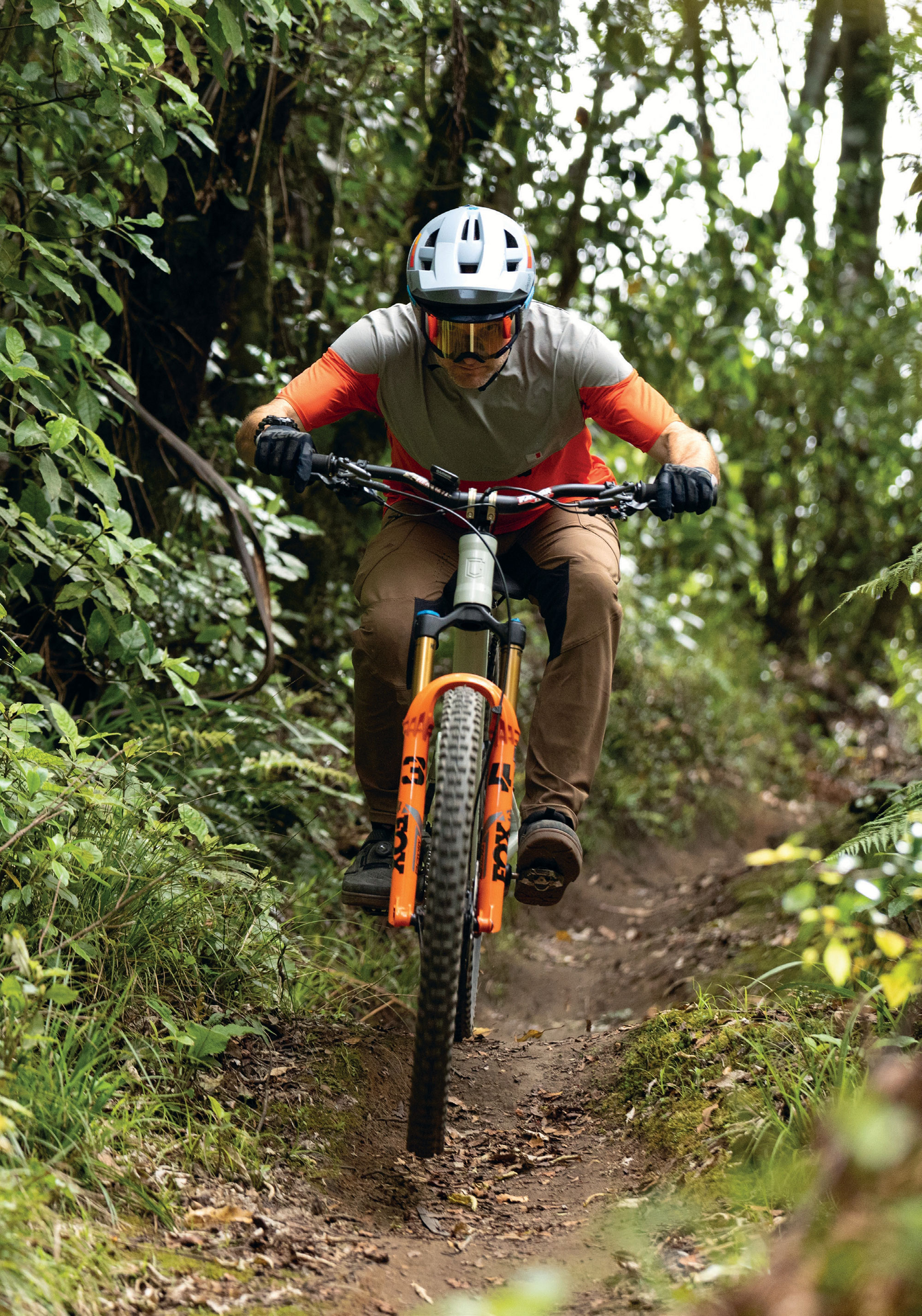
Shock
The Fox Float Factory, in its stock format, suited me perfectly, and no tweaking was required from Commencal’s initial recommendations. There’s a lockout lever in easy reach while riding and I used this a lot while climbing on gravel roads or smooth trails. A dial also offers two additional compression levels when the shock is ‘open’. I played a bit with these but found the bike’s overall feel much nicer in the lowest setting. It certainly pedalled better in the second or third setting than when fully open, but the added compression stunted the feel and was only a bonus on smooth trails where I’d throw the lockout anyway.
Fork
Front suspension is handled by a Fox 34 Factory with 140mm travel. There’s all the adjustment one would want, with low and high-speed rebound and compression dials. Interestingly, the spec sheet listed the fork as having a 51mm offset, something that I thought had gone away almost entirely these days in favour of 44mm versions. I initially thought maybe it was a typo but, sure enough, the bike turned up with the 51mm offset fork. Perhaps smaller travel bikes suit the larger offset? Whatever the case, I never gave it a second thought. Once I was out on the trail, it turned out that a bike still handles fine without the much-hyped 44mm offset. Who would have thought?! (I say this in jest!)
I was stoked on this fork; anything less would hamper the bike’s overall performance, and the 34 took everything I could throw at it. I’m 80kg, so not a lightweight, but I didn’t notice any untoward flex and, regardless of the trail, the fork was controlled and felt well damped. They say something works well if you never have to give it any thought, and this fork was proof of that. I backed off one click of highspeed rebound from recommended and called it good.
Drivetrain
The combination of a SRAM GX Eagle derailleur, shifter, cassette and chain takes care of shifting. While this stuff does the job, it wouldn’t be my first port of call for an upgrade on this bike, given the accessibility, accuracy and reliability of electronic derailleurs these days.
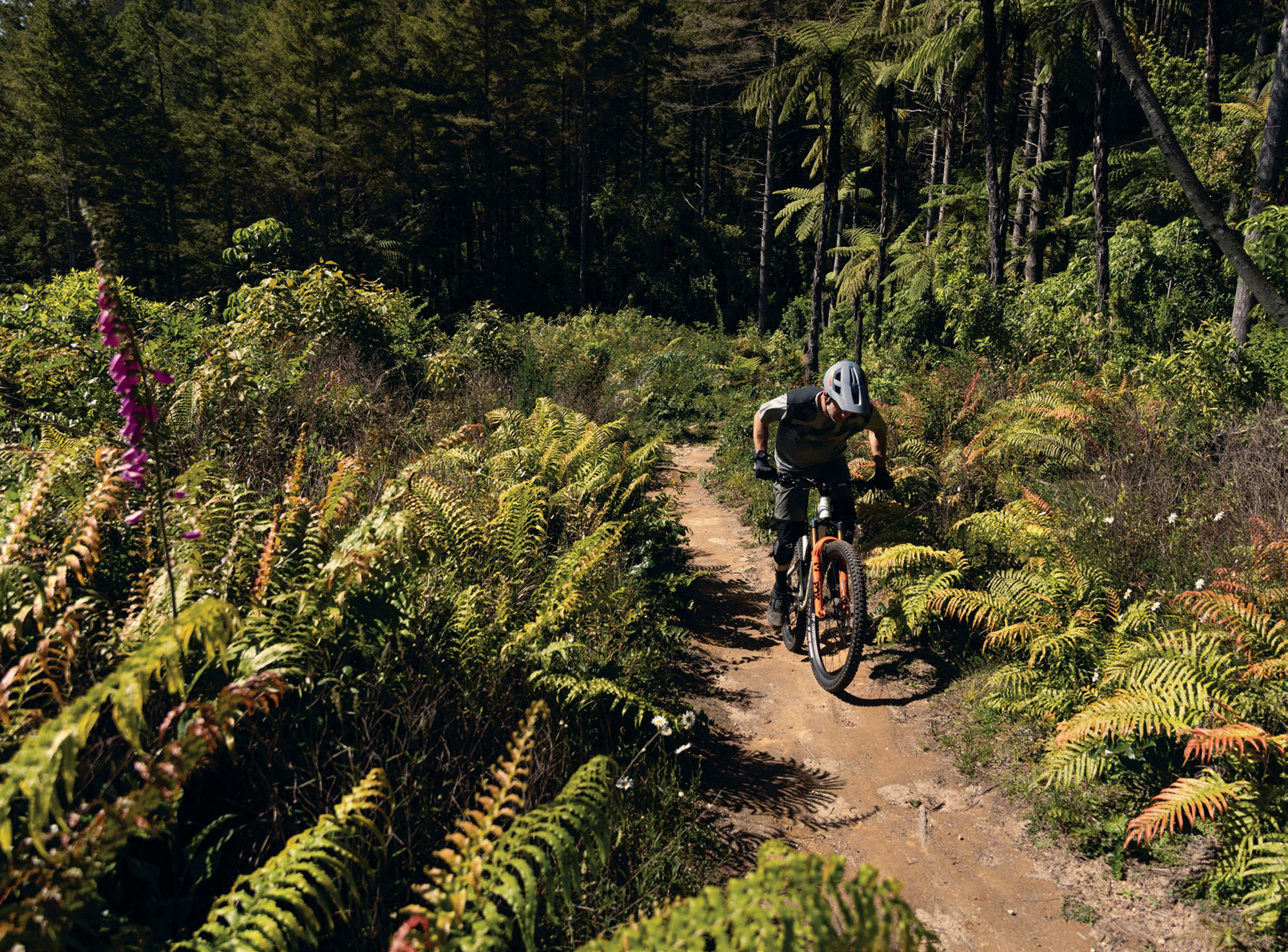
The Ride
From early 2024 until I took possession of the Tempo in October ‘24, I’d been getting about on either a 160-170mm travel Enduro bike or a full-gas XC race bike. So, I was keen to get on board a modern, short-travel trail bike, hoping that it would be more suited to how and where I ride most of the time.
As is the norm for me on many brands, I sit between the medium and large recommendations on the Tempo, so I chose to size down rather than up. With the steep seat tube and short reach (450mm), the bike felt short when seated but put me in a nice central position between the wheels, and the ample stack combined with the 30mm rise bar put my hands up relatively high, giving me a distinct feeling of confidence; helping the bike feel like it would handle more than it’s suspension travel numbers would first suggest.
I’d convey the vibe of the bike as “playful”—akin to a big wheeled BMX in many scenarios. It excels when you’re being creative on the trail and allows for a super dynamic riding style; jumps, manuals, Scandi flicks and nose bonks are all in the Tempo’s remit, but it’s equally at home just cruising around in more of a ‘cross country’ mode.
Seated climbing is excellent. The steep seat tube helped put a good amount of weight on the front tyre, helping retain control when threading the needle between obstacles or up steep switchbacks or steps. Climbing steep pitches out of the saddle, the suspension extends nicely, giving a firm platform to push against and a relatively snappy feel. At over 14kg, and with components designed for longevity rather than light weight, it’s unlikely a rider would be getting any climbing KOMs on the Tempo. Still, at least it gets you to the top of the hill efficiently and without feeling like you’re dragging an anchor.
I commented in my Meta V5 review about how easy it was to change directions and drive through turns, and the Tempo retains this feeling. It straight-up rips turns—flat or bermed. I have fond memories of blasting through successive steep berms at the Whangamata MTB park, surprised by how it transitioned from one to the other. The only drawback of short travel like this is that rough and loose corners take a little more finesse to maintain traction; less travel means less sag and, ultimately, less traction.
Snapping out of turns, and under power while coming from a dead stop, the bike gets up to speed well and there’s no excessive loss of energy to the suspension.
Descending on the Tempo is surprising. It’s not the first small-travel bike to ride like it has more travel, but it would be one of the better ones, leaving nothing on the table. With only 125mm of travel, it can’t offer a big bike ‘buttery’ feel as it sits into its sag, but it does a great job of quieting the chatter on the trail. It doesn’t blow through travel to an uncontrolled or harsh bottom out during larger hits or g-outs.
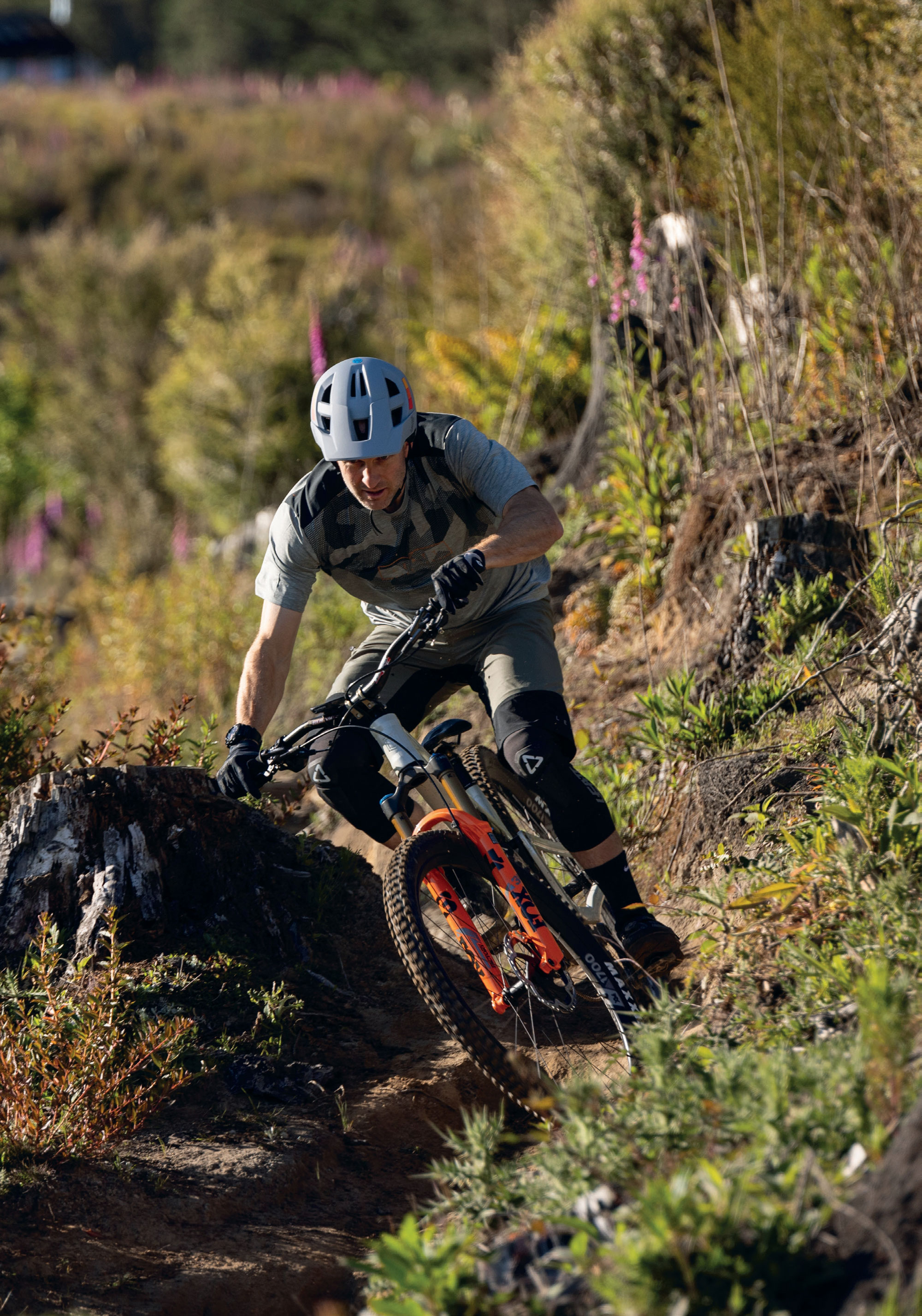
The Tempo is stable at speed, although the nature of its shorter travel means it’s not as planted as the Meta V5 or other similar Enduro bikes, and needs more brains and less brawn to deal with rough terrain. Aboard a bigger bike, one could essentially point and shoot, standing on the pedals and having the bike do all the work—the Tempo isn’t that sort of bike…. it’s true that you can’t have your cake and eat it too.
The 125mm of suspension is enough—until it isn’t. Over my three-month stint with the Tempo, there were a few times I came into a rough section a bit hot and really had to keep my wits about me as I used every millimetre of the travel, then relied on strength, skill and (possibly more so in my case) luck, to keep the ship upright. These situations were few and far between, but it’s worth keeping in mind that there’s not the safety net that a full enduro bike would offer. Although that’s not what anyone riding this bike would be after anyway.
I like a big day in the saddle, under my own steam, and I don’t like to feel like my fun is hampered by my choice of bike – regardless of whether I’m headed up or downhill. Living in the Waikato, the majority of my riding (all within a couple of hours’ drive) is on trails tending more towards the mellow end of the spectrum. Lots of digger-built trails and not so many gnarly, steep, rocky, “heck, I hope I can make this” sort of trails—unless I’m away in Nelson or Queenstown, which is once or twice a year, if I’m lucky. With this in mind, I’ve settled on the fact that a bike like the Tempo is realistically all I need: the ability to cover a decent amount of ground, climb effectively up hills, and be able to bomb back down whatever trail I choose without feeling like I’m being held back by inactive suspension or pucker-inducing handling.
Although I didn’t need to faff with the linkage at all, if I needed to—due to the layout of the VCS linkage and pivots—accessing the bottom shock bolt or pivot bolts can be a bit niggly; needing to remove some pivot bolts to access others. Not impossible, just time-consuming. If something in the back end comes loose while out on the trail, you’ll be holding up your riding buddies for a few minutes while you get it sorted.
The internal headset cable routing is the most polarising feature of the Tempo. Cables for the rear derailleur, dropper post and rear brake all squeeze their way through the headset top cap and down through the top bearing. There’s a bit going on up front. I’m yet to have a review bike long enough to need to replace a headset bearing and, if I had, I’m sure I’d do myself the favour of taking it to a bike shop with a mechanic who has far more patience than I do to complete the procedure. It’s fair to say that simply cracking the headset open, cleaning everything, popping off the bearing seal and re-lubing it once a month or so (depending on riding conditions) would drastically increase its lifespan. Spending 15 minutes doing this periodically is easier than a bearing replacement, which could take upwards of an hour.
Final thoughts
It’s taken some time for manufacturers to get little bikes ‘right’, but it seems they’re finally getting them dialled, bringing a shift in the mountain bike market as people realise a bike with “just” 125mm travel can handle everything they throw at it. Depending on where people ride, they probably don’t need a big travel bike as their daily rig. I’m now one of these people, and I’ve had an absolute blast riding the Tempo over the summer. I still have questions about headset routing and pivot bearing servicing over a longer term and through a winter of riding but, so far, I’m grinning.



